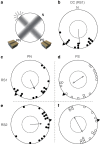A functional role of the sky's polarization pattern for orientation in the greater mouse-eared bat
- PMID: 25050897
- PMCID: PMC4109006
- DOI: 10.1038/ncomms5488
A functional role of the sky's polarization pattern for orientation in the greater mouse-eared bat
Abstract
Animals can call on a multitude of sensory information to orient and navigate. One such cue is the pattern of polarized light in the sky, which for example can be used by birds as a geographical reference to calibrate other cues in the compass mechanism. Here we demonstrate that the female greater mouse-eared bat (Myotis myotis) uses polarization cues at sunset to calibrate a magnetic compass, which is subsequently used for orientation during a homing experiment. This renders bats the only mammal known so far to make use of the polarization pattern in the sky. Although there is currently no clear understanding of how this cue is perceived in this taxon, our observation has general implications for the sensory biology of mammalian vision.
Figures


Similar articles
-
A nocturnal mammal, the greater mouse-eared bat, calibrates a magnetic compass by the sun.Proc Natl Acad Sci U S A. 2010 Apr 13;107(15):6941-5. doi: 10.1073/pnas.0912477107. Epub 2010 Mar 29. Proc Natl Acad Sci U S A. 2010. PMID: 20351296 Free PMC article.
-
Calibration of magnetic and celestial compass cues in migratory birds--a review of cue-conflict experiments.J Exp Biol. 2006 Jan;209(Pt 1):2-17. doi: 10.1242/jeb.01960. J Exp Biol. 2006. PMID: 16354773 Review.
-
Polarized skylight does not calibrate the compass system of a migratory bat.Biol Lett. 2015 Sep;11(9):20150525. doi: 10.1098/rsbl.2015.0525. Biol Lett. 2015. PMID: 26382077 Free PMC article.
-
A New View on an Old Debate: Type of Cue-Conflict Manipulation and Availability of Stars Can Explain the Discrepancies between Cue-Calibration Experiments with Migratory Songbirds.Front Behav Neurosci. 2016 Feb 23;10:29. doi: 10.3389/fnbeh.2016.00029. eCollection 2016. Front Behav Neurosci. 2016. PMID: 26941631 Free PMC article.
-
Integration of polarization and chromatic cues in the insect sky compass.J Comp Physiol A Neuroethol Sens Neural Behav Physiol. 2014 Jun;200(6):575-89. doi: 10.1007/s00359-014-0890-6. Epub 2014 Mar 5. J Comp Physiol A Neuroethol Sens Neural Behav Physiol. 2014. PMID: 24589854 Review.
Cited by
-
Biological Effects of Electric, Magnetic, and Electromagnetic Fields from 0 to 100 MHz on Fauna and Flora: Workshop Report.Health Phys. 2023 Jan 1;124(1):39-52. doi: 10.1097/HP.0000000000001624. Epub 2022 Nov 3. Health Phys. 2023. PMID: 36480584 Free PMC article.
-
Magnetic alignment enhances homing efficiency of hunting dogs.Elife. 2020 Jun 16;9:e55080. doi: 10.7554/eLife.55080. Elife. 2020. PMID: 32539933 Free PMC article.
-
Migratory bats are attracted by red light but not by warm-white light: Implications for the protection of nocturnal migrants.Ecol Evol. 2018 Aug 25;8(18):9353-9361. doi: 10.1002/ece3.4400. eCollection 2018 Sep. Ecol Evol. 2018. PMID: 30377506 Free PMC article.
-
Measurement Modeling and Performance Analysis of a Bionic Polarimetric Imaging Navigation Sensor Using Rayleigh Scattering to Generate Scattered Sunlight.Sensors (Basel). 2024 Jan 13;24(2):0. doi: 10.3390/s24020498. Sensors (Basel). 2024. PMID: 38257591 Free PMC article.
-
Flight behaviour and short-distance homing by nomadic grey-headed flying-foxes: a pilot study.Mov Ecol. 2025 Mar 25;13(1):22. doi: 10.1186/s40462-025-00532-x. Mov Ecol. 2025. PMID: 40134011 Free PMC article.
References
-
- Papi F. Animal Homing Chapman & Hall (1992).
-
- Muheim R., Phillips J. B. & Akesson S. Polarized light cues underlie compass calibration in migratory songbirds. Science 313, 837–839 (2006). - PubMed
-
- Muheim R., Phillips J. B. & Deutschlander M. E. White-throated sparrows calibrate their magnetic compass by polarized light cues during both autumn and spring migration. J. Exp. Biol. 212, 3466–3472 (2009). - PubMed
-
- Muheim R., Moore F. R. & Phillips J. B. Calibration of magnetic and celestial compass cues in migratory birds--a review of cue-conflict experiments. J. Exp. Biol. 209, 2–17 (2006). - PubMed
-
- Phillips J. & Moore F. Calibration of the sun compass by sunset polarized light patterns in a migratory bird. Behav. Ecol. Sociobiol. 31, 189–193 (1992).
Publication types
MeSH terms
LinkOut - more resources
Full Text Sources
Other Literature Sources
Miscellaneous

